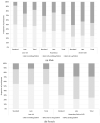Association between Bar Closing Time, Alcohol Use Disorders and Blood Alcohol Concentration: A Cross-Sectional Observational Study of Nightlife-Goers in Perth, Australia
- PMID: 35742275
- PMCID: PMC9223176
- DOI: 10.3390/ijerph19127026
Association between Bar Closing Time, Alcohol Use Disorders and Blood Alcohol Concentration: A Cross-Sectional Observational Study of Nightlife-Goers in Perth, Australia
Abstract
Introduction and aims: Associations between bar trading hours, a government lever for controlling alcohol availability, nightlife-goer intoxication levels and their likelihood of alcohol use disorder (AUD) have not been explored. We investigated whether: (i) participant AUD was associated with blood alcohol concentration (BAC); and, (ii) any association between AUD and BAC was moderated by participant preferred bar (i.e., venue spent most time at) closing time. Design and methods: A cross-sectional observational study using a sample of nightlife-goers who went out drinking in Perth, Western Australia, on weekends in 2015-16. Participants who reported alcohol use that night and spent most time in a bar (n = 667) completed street intercept surveys including AUDIT-C (n = 459) and provided a breath sample to estimate BAC (n = 651). We used gender-specific multinomial logistic regression models to explore associations between participant AUDIT-C score (1−4, lower risk; 5−7, hazardous; 8−12, active AUD), preferred bar type (standard vs. late closing time based on absence or presence of an extended trading permit) and BAC (male: 0−0.049, 0.05−0.099, ≥0.1 g/100 mL; female: 0−0.049, 0.05−0.079, ≥0.08 g/100 mL). Results: Males with active AUD (RR = 3.31; 95% CI 1.30−8.42; p = 0.01) and females with hazardous/active AUD (RR = 9.75; 95% CI 2.78−34.21; p < 0.001) were both more likely to have high-range BAC than their counterparts typically drinking at lower risk. We also found preferred bar type moderated the association between AUDIT-C score and BAC for some males but no females. Males with active AUD and high-range BAC were less likely to prefer late closing bars than males usually drinking at lower risk and high-range BAC (RR = 0.12; 95% CI 0.02−0.96; p = 0.046). Discussion and conclusions: Our study provides evidence of positive associations between AUD and acute intoxication among nightlife-goers and on the moderating effect of bar closing times among males.
Keywords: AUDIT-C; BAC; alcohol policy; alcohol use disorders; bars; blood alcohol concentration; closing times; nightlife-goers; on-trade licensed outlets; trading hours.
Conflict of interest statement
P.M. has acted as a paid expert witness on behalf of a licensed venue and a security firm. Other authors declare that they have no conflict of interest.
Figures
Similar articles
-
Association between Nightlife Goers' Likelihood of an Alcohol Use Disorder and Their Preferred Bar's Closing Time: A Cross-Sectional Observational Study in Perth, Australia.Int J Environ Res Public Health. 2021 Dec 10;18(24):13040. doi: 10.3390/ijerph182413040. Int J Environ Res Public Health. 2021. PMID: 34948660 Free PMC article.
-
Comparing levels of blood alcohol concentration and indicators of impairment in nightlife patrons.Drug Alcohol Rev. 2018 Apr;37 Suppl 1:S348-S356. doi: 10.1111/dar.12639. Epub 2017 Dec 7. Drug Alcohol Rev. 2018. PMID: 29218751
-
Short-term changes in nightlife attendance and patron intoxication following alcohol restrictions in Queensland, Australia.BMC Public Health. 2018 Nov 12;18(1):1185. doi: 10.1186/s12889-018-6098-x. BMC Public Health. 2018. PMID: 30415643 Free PMC article.
-
Emergency department wait times in concordance with blood alcohol content and subsequent alcohol use disorder.J Osteopath Med. 2025 Apr 25. doi: 10.1515/jom-2024-0168. Online ahead of print. J Osteopath Med. 2025. PMID: 40270462 Review.
-
Identification and management of acute alcohol intoxication.Eur J Intern Med. 2023 Feb;108:1-8. doi: 10.1016/j.ejim.2022.08.013. Epub 2022 Aug 16. Eur J Intern Med. 2023. PMID: 35985955 Review.
References
-
- Stockwell T., Gruenewald P. Controls on physical availability of alcohol. In: Heather N., Stockwell T., editors. The Essential Handbook of Treatment and Prevention of Alcohol Problems. Wiley and Sons; Hoboken, NJ, USA: 2004.
-
- Stockwell T., Chikritzhs T. Do relaxed trading hours for bars and clubs mean more relaxed drinking? A review of international research on the impacts of changes to permitted hours of drinking. Crime Prev. Commun. Saf. 2009;11:153–170. doi: 10.1057/cpcs.2009.11. - DOI
-
- Hahn R.A., Kuzara J.L., Elder R., Brewer R., Chattopadhyay S., Fielding J., Naimi T.S., Toomey T., Middleton J.C., Lawrence B. Effectiveness of policies restricting hours of alcohol sales in preventing excessive alcohol consumption and related harms. Am. J. Prev. Med. 2010;39:590–604. doi: 10.1016/j.amepre.2010.09.016. - DOI - PMC - PubMed
-
- Holmes J., Guo Y., Maheswaran R., Nicholls J., Meier P.S., Brennan A. The impact of spatial and temporal availability of alcohol on its consumption and related harms: A critical review in the context of UK licensing policies. Drug Alcohol Rev. 2014;33:515–525. doi: 10.1111/dar.12191. - DOI - PMC - PubMed
Publication types
MeSH terms
Substances
LinkOut - more resources
Full Text Sources
Medical


